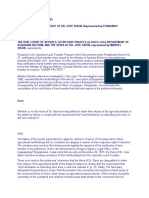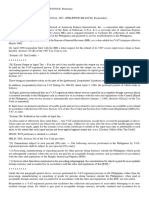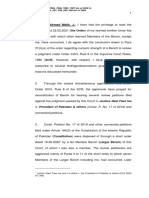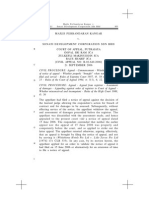People of The Philippines Versus Renerio P. Vergara, Ernesto T. Cuesta JR., Pedro G. Dagao and Bernardo P. Cuesta, G.R. No. 110286, April 2, 1997
People of The Philippines Versus Renerio P. Vergara, Ernesto T. Cuesta JR., Pedro G. Dagao and Bernardo P. Cuesta, G.R. No. 110286, April 2, 1997
Uploaded by
Anonymous ubixYACopyright:
Available Formats
People of The Philippines Versus Renerio P. Vergara, Ernesto T. Cuesta JR., Pedro G. Dagao and Bernardo P. Cuesta, G.R. No. 110286, April 2, 1997
People of The Philippines Versus Renerio P. Vergara, Ernesto T. Cuesta JR., Pedro G. Dagao and Bernardo P. Cuesta, G.R. No. 110286, April 2, 1997
Uploaded by
Anonymous ubixYAOriginal Description:
Original Title
Copyright
Available Formats
Share this document
Did you find this document useful?
Is this content inappropriate?
Copyright:
Available Formats
People of The Philippines Versus Renerio P. Vergara, Ernesto T. Cuesta JR., Pedro G. Dagao and Bernardo P. Cuesta, G.R. No. 110286, April 2, 1997
People of The Philippines Versus Renerio P. Vergara, Ernesto T. Cuesta JR., Pedro G. Dagao and Bernardo P. Cuesta, G.R. No. 110286, April 2, 1997
Uploaded by
Anonymous ubixYACopyright:
Available Formats
People of the Philippines versus Renerio P. Vergara, Ernesto T.
Cuesta
Jr., Pedro G. Dagao and Bernardo P. Cuesta,
G.R. No. 110286, April 2, 1997.
Facts:
At about 7:30 in the morning of July 4, 1992, a team consisting of
deputized Fish Warden and President of the Leyte Fish Warden
Association Jesus P. Bindoy, Police Officers Casimiro Villas and Diosdado
Moron of the Palo PNP Station, Leyte, Fish Wardens Mario Castillote and
Estanislao Cabreros and Fish Examiner Nestor Aldas of the Department of
Agriculture were on board, "Bantay-Dagat," a pumpboat, on "preventive
patrol" along the municipal waters fronting barangays Baras and Candahug
of Palo, Leyte, stumbled upon a blue-colored fishing boat at a distance of
approximately 200 meters away. On the said boat were Renerio Vergara
and his three co-accused Bernardo Cuesta, Pedro Dagao and Ernesto
Cuesta, Jr., They were on a parallel course toward the general direction of
Samar.
Momentarily, the team saw Vergara throw into the sea a bottle known in
the locality as "badil" containing ammonium nitrate and having a blasting
cap on top which, when ignited and thrown into the water, could
explode. The explosion would indiscriminately kill schools and various
species of fish within a certain radius. Approximately three seconds after
appellant had thrown the "badil" into the sea, the explosion occurred.
Vergara and Cuesta then dove into the sea with their gear while Dagao and
Cuesta, Jr., stayed on board to tend to the air hose for the divers.
The team approached the fishing boat. SPO2 Casimiro Villas boarded
the fishing boat while Fish Warden Jesus Bindoy held on to one end of the
boat. Moments later, Vergara and Cuesta surfaced, each carrying a fishnet
or "sibot" filled with about a kilo of "bolinao" fish scooped from under the
water. Having been caught red-handed, the four accused were
apprehended and taken by the patrol team to the "Bantay-Dagat" station at
Baras, and later to the police station in Palo, Leyte. The fishing boat and its
paraphernalia, as well as the two fishnets of "bolinao," were
impounded. The accused, however, refused to sign and acknowledge the
corresponding receipts therefor.
On February 10, 1993, the trial court rendered judgment convicting
Vergara. Vergara then appealed to the CA.
Issue:
Whether the Court committed grave abuse of authority when it
completely ignored the testimony of Emilio Linde.
Held:
No. Emilio Linde sought to corroborate the claim of appellant that it
was another unidentified group of fishermen who threw the bottle of
explosives at a school of "bolinao" fish. It was obvious, however, said the
trial court, that the statement of this defense witness was incredulous since
he apparently had not at all been on board the fishing boat in the company
of the accused at the time of the incident. Even the rather lengthy counteraffidavit of the four accused completely missed to mention Linde. The
court a quo went on to observe that the demeanor of the accused at the
witness stand and the substance of his testimony failed to elicit belief.
Trial courts are tasked to initially rule on the credibility of witnesses for
both the prosecution and the defense. Appellate courts seldom would
subordinate, with their own, the findings of trial courts which concededly
have good vantage points in assessing the credibility of those who take the
witness stand. Nevertheless, it is not all too uncommon for this Court, in
particular, to peruse through the transcript of proceedings in order to satisfy
itself that the records of a case do support the conclusions of trial
courts.The Court is convinced that the trial court has acted correctly in
finding accused-appellant guilty of the offense charged.
You might also like
- Natural Resources and Environmental Law REVIEWER - CabuhatDocument31 pagesNatural Resources and Environmental Law REVIEWER - CabuhatMilea Kim Karla Cabuhat90% (164)
- Natural Resources & Environmental Law (Nat Res) NotesDocument16 pagesNatural Resources & Environmental Law (Nat Res) NotesDiane Garduce100% (11)
- SARIGUMBA - Summit One Vs Pollution Adjudication BoardDocument2 pagesSARIGUMBA - Summit One Vs Pollution Adjudication BoardMiguel Louie Sarigumba III75% (4)
- Republic vs. RosemoorDocument2 pagesRepublic vs. RosemoorYong Naz100% (3)
- Law On Natural Resources ReviewerDocument108 pagesLaw On Natural Resources ReviewerGeoanne Battad Beringuela90% (39)
- Hizon vs. CaDocument2 pagesHizon vs. Caangelescrishanne100% (2)
- People V Vergara: Explosives With Intent To Use The Same For Illegal Fishing Shall Be PunishableDocument1 pagePeople V Vergara: Explosives With Intent To Use The Same For Illegal Fishing Shall Be Punishabletops videosNo ratings yet
- 45 - Hizon v. CA Case DigestDocument1 page45 - Hizon v. CA Case DigestMay Angelica TenezaNo ratings yet
- Merida v. People of The PhilippinesDocument1 pageMerida v. People of The PhilippinesKMNo ratings yet
- Hizon vs. Court of AppealsDocument1 pageHizon vs. Court of AppealsMrln VloriaNo ratings yet
- Sea Lion Vs People Case DigestDocument1 pageSea Lion Vs People Case Digestdiamajolu gaygons100% (1)
- Case Digests I Environmental Laws and Natural ResourcesDocument44 pagesCase Digests I Environmental Laws and Natural ResourcesRyan Christian Lupos50% (2)
- Monge v. People of The PhilippinesDocument1 pageMonge v. People of The PhilippinesDaniela Sandra AgootNo ratings yet
- Leynes v. PeopleDocument3 pagesLeynes v. Peopleloverlybarquez100% (2)
- Oposa V Factoran Case Digest (Gianan, Meryshel S.)Document3 pagesOposa V Factoran Case Digest (Gianan, Meryshel S.)shelNo ratings yet
- G.R. No. 199199Document3 pagesG.R. No. 199199Eap BustilloNo ratings yet
- Cenzon Vs AlipingDocument1 pageCenzon Vs AlipingTin CaddauanNo ratings yet
- Digest GR 134030 Asaphil V TuasonDocument3 pagesDigest GR 134030 Asaphil V TuasonGracia Sullano100% (3)
- 23 Provident Tree vs. BatarioDocument2 pages23 Provident Tree vs. BatarioHenry L100% (1)
- Aquino v. People of The Philippines G.R. No. 165448Document1 pageAquino v. People of The Philippines G.R. No. 165448Norie Sapanta100% (1)
- Lepanto Consolidated Mining CoDocument2 pagesLepanto Consolidated Mining CoBingoheartNo ratings yet
- Villarin Vs PeopleDocument1 pageVillarin Vs PeopleAthena Santos100% (1)
- Reaction Paper For Revised Forestry CodeDocument1 pageReaction Paper For Revised Forestry CodeJona Myka DugayoNo ratings yet
- Tenanst of Estate of DR Jose SisonDocument2 pagesTenanst of Estate of DR Jose SisonClea C. LagcoNo ratings yet
- GR L-52518 Intl Hardwood Vs UpDocument2 pagesGR L-52518 Intl Hardwood Vs UpGreta BipsNo ratings yet
- 7) Aquino v. People of The PhilippinesDocument2 pages7) Aquino v. People of The PhilippinesDaniela Sandra AgootNo ratings yet
- Felix Ting Ho JR Vs Vicente Teng Gui PDFDocument4 pagesFelix Ting Ho JR Vs Vicente Teng Gui PDFTashNo ratings yet
- CASE DIGESTS On Environmental LawsDocument61 pagesCASE DIGESTS On Environmental Lawsgrurocket89% (9)
- Rodolfo Tigoy v. Court of AppealsDocument2 pagesRodolfo Tigoy v. Court of AppealsDaniela Sandra AgootNo ratings yet
- Written Report - Brown LawsDocument68 pagesWritten Report - Brown LawsJayson A. GalaponNo ratings yet
- Jurisprudence On Forestry: 1. Ma. Mimie Crescencio vs. People of The PhilippinesDocument2 pagesJurisprudence On Forestry: 1. Ma. Mimie Crescencio vs. People of The Philippinesgellietan67% (3)
- Salient Features of RA 8550 As AmendedDocument116 pagesSalient Features of RA 8550 As AmendedHaidisheena Allama100% (1)
- Perfecto Pallada v. People of The PhilippinesDocument2 pagesPerfecto Pallada v. People of The PhilippinesDaniela Sandra AgootNo ratings yet
- Mustang Lumber Inc. vs. CA 257 Scra 430Document2 pagesMustang Lumber Inc. vs. CA 257 Scra 430Georgette V. Salinas83% (6)
- Republic V Tri Case DigestDocument2 pagesRepublic V Tri Case DigestCherry May SanchezNo ratings yet
- Republic of The Philippines vs. Rosemoor Mining and Development CorporationDocument2 pagesRepublic of The Philippines vs. Rosemoor Mining and Development CorporationloschudentNo ratings yet
- Pilar Cañeda Braga Vs Abaya G.R. No. 223076Document2 pagesPilar Cañeda Braga Vs Abaya G.R. No. 223076Ars Moriendi100% (4)
- Otadan vs. Rio Tuba Nickel Mining CorpDocument1 pageOtadan vs. Rio Tuba Nickel Mining CorplookalikenilongNo ratings yet
- PICOP Resources v. Base MetalsDocument2 pagesPICOP Resources v. Base MetalsAra Lim100% (1)
- Sea Lion Fishing Corp. V PeopleDocument3 pagesSea Lion Fishing Corp. V PeopleCarlos JamesNo ratings yet
- Revised Forestry CodeDocument65 pagesRevised Forestry CodeJanjan DumaualNo ratings yet
- Merida V PeopleDocument1 pageMerida V PeopleDaniela Sandra AgootNo ratings yet
- Property - INTERNATIONAL HARDWOOD AND VENEER COMPANY OF THE PHILIPPINES Vs UP, G.R. No. L-52518 August 13, 1991.Document2 pagesProperty - INTERNATIONAL HARDWOOD AND VENEER COMPANY OF THE PHILIPPINES Vs UP, G.R. No. L-52518 August 13, 1991.Lewrej De PerioNo ratings yet
- Republic vs. Rosemoor MiningDocument4 pagesRepublic vs. Rosemoor MiningWilfredNo ratings yet
- Ls213digest MallariDocument20 pagesLs213digest MallariKaren Faith MallariNo ratings yet
- 10 Agra DigestDocument3 pages10 Agra DigestJanette TitoNo ratings yet
- Rodolfo Tigoy v. Court of Appeals G.R. No. 144640Document1 pageRodolfo Tigoy v. Court of Appeals G.R. No. 144640Norie SapantaNo ratings yet
- Metro Iloilo Water District v. CADocument2 pagesMetro Iloilo Water District v. CALoreen Danao100% (4)
- Lepanto Consolidated Mining Co Vs WMCDocument2 pagesLepanto Consolidated Mining Co Vs WMCRix DagzNo ratings yet
- Provident Tree Farms, Inc. v. Hon. DemetrioDocument2 pagesProvident Tree Farms, Inc. v. Hon. DemetrioTin CaddauanNo ratings yet
- Didipio Earth-Savers' vs. GozunDocument2 pagesDidipio Earth-Savers' vs. GozunMonica Gerero - Barquilla100% (1)
- ARBA vs. Nicolas G.R. No. 168394Document2 pagesARBA vs. Nicolas G.R. No. 168394Marianne Andres100% (1)
- 15 People v. Cubelo, 106 Phil. 496, Nov. 20, 1959Document2 pages15 People v. Cubelo, 106 Phil. 496, Nov. 20, 1959mae ann rodolfoNo ratings yet
- 02 Villarin V People Case DigestDocument1 page02 Villarin V People Case DigestDawn Jessa Go100% (1)
- Daylinda A. Lagua, Et Al. v. Hon. Vicente N. Cusi, Et Al.Document1 pageDaylinda A. Lagua, Et Al. v. Hon. Vicente N. Cusi, Et Al.Daniela Sandra AgootNo ratings yet
- Daylinda A. Lagua, Et Al. v. Hon. Vicente N. Cusi, Et Al.Document1 pageDaylinda A. Lagua, Et Al. v. Hon. Vicente N. Cusi, Et Al.KM100% (2)
- Republic v. Rosemoor G.R. No. 149927, March 30, 2004 FactsDocument2 pagesRepublic v. Rosemoor G.R. No. 149927, March 30, 2004 FactsMariel CabubunganNo ratings yet
- People of The Philippines Versus Renerio PDocument2 pagesPeople of The Philippines Versus Renerio PKaren Sheila B. Mangusan - DegayNo ratings yet
- Ra 8550 - 2. Prohibited ActsDocument24 pagesRa 8550 - 2. Prohibited ActsKIM COLLEEN MIRABUENANo ratings yet
- People of The Philippines v. Vergara, GR No.110286, April 2, 1997Document9 pagesPeople of The Philippines v. Vergara, GR No.110286, April 2, 1997code4saleNo ratings yet
- G.R. No. 226846 People OF THE PHILIPPINES, Plaintiff-Appellee JEFFREY MACARANAS y FERNANDEZ, Accused-Appellant Decision Peralta, J.Document6 pagesG.R. No. 226846 People OF THE PHILIPPINES, Plaintiff-Appellee JEFFREY MACARANAS y FERNANDEZ, Accused-Appellant Decision Peralta, J.Anonymous ubixYANo ratings yet
- People Vs BidtuDocument3 pagesPeople Vs BidtuAnonymous ubixYANo ratings yet
- Version of The ProsecutionDocument6 pagesVersion of The ProsecutionAnonymous ubixYANo ratings yet
- People Vs Edwin DagsaDocument11 pagesPeople Vs Edwin DagsaAnonymous ubixYANo ratings yet
- People Vs Edwin DagsaDocument11 pagesPeople Vs Edwin DagsaAnonymous ubixYANo ratings yet
- Ombudsman Vs DechavesDocument4 pagesOmbudsman Vs DechavesAnonymous ubixYANo ratings yet
- Cir Vs American ExpressDocument2 pagesCir Vs American ExpressAnonymous ubixYANo ratings yet
- Filemon A. Verzano, JR., G.R. No. 171643 PresentDocument8 pagesFilemon A. Verzano, JR., G.R. No. 171643 PresentAnonymous ubixYANo ratings yet
- DisinheritanceDocument3 pagesDisinheritanceAnonymous ubixYA80% (5)
- Almocera Vs OngDocument6 pagesAlmocera Vs OngAnonymous ubixYANo ratings yet
- Lupo Almodiel AtienzaDocument2 pagesLupo Almodiel AtienzaAnonymous ubixYANo ratings yet
- G.R. NO. 190475: April 10, 2013 JAIME ONG y ONG, Petitioner, v. PEOPLE OF THE PHILIPPINES, Respondent. Decision Sereno, C.J.Document3 pagesG.R. NO. 190475: April 10, 2013 JAIME ONG y ONG, Petitioner, v. PEOPLE OF THE PHILIPPINES, Respondent. Decision Sereno, C.J.Anonymous ubixYANo ratings yet
- Information For HomicideDocument2 pagesInformation For HomicideAnonymous ubixYANo ratings yet
- Identification Document/card Which Contains A Photograph and Signature Bearing No. - Issued byDocument2 pagesIdentification Document/card Which Contains A Photograph and Signature Bearing No. - Issued byAnonymous ubixYANo ratings yet
- Legal Forms-Sample Form of Petition For ProhibitionDocument1 pageLegal Forms-Sample Form of Petition For Prohibitiondenvergamlosen100% (1)
- The Travelers Indemnity Co., A Connecticut Corporation v. Ewing, Cole, Erdman & Eubank, A Pennsylvania Partnership. Ewing, Cole, Erdman & Eubank, 711 F.2d 14, 3rd Cir. (1983)Document6 pagesThe Travelers Indemnity Co., A Connecticut Corporation v. Ewing, Cole, Erdman & Eubank, A Pennsylvania Partnership. Ewing, Cole, Erdman & Eubank, 711 F.2d 14, 3rd Cir. (1983)Scribd Government DocsNo ratings yet
- Lumumba V ST Dominic Change of VenueDocument9 pagesLumumba V ST Dominic Change of Venuethe kingfishNo ratings yet
- McConnel V CADocument2 pagesMcConnel V CARaymond Cheng100% (2)
- Windsor Lawless AmericaDocument190 pagesWindsor Lawless AmericaRichNo ratings yet
- Provisional RemediesDocument9 pagesProvisional RemediesAl-kevin AmingNo ratings yet
- 'Cowboys & Aliens' LawsuitDocument8 pages'Cowboys & Aliens' LawsuitSharonWaxmanNo ratings yet
- United States v. Gabriel Ceballos, Also Known As Sealed Deft. 3, Also Known As Gabriel Lnu, 340 F.3d 115, 2d Cir. (2003)Document18 pagesUnited States v. Gabriel Ceballos, Also Known As Sealed Deft. 3, Also Known As Gabriel Lnu, 340 F.3d 115, 2d Cir. (2003)Scribd Government DocsNo ratings yet
- Minutes Showing Denial of Motion For Summary JudgmentDocument2 pagesMinutes Showing Denial of Motion For Summary JudgmentBasseemNo ratings yet
- People Vs Binondo GR97227 Oct 20 1992Document5 pagesPeople Vs Binondo GR97227 Oct 20 1992Jessie AncogNo ratings yet
- Bench Guide 104Document127 pagesBench Guide 104Thee Lesserof Twoevils100% (1)
- Al Amman Case DigestDocument2 pagesAl Amman Case DigestKaye PascualNo ratings yet
- Padilla ReviewerDocument166 pagesPadilla RevieweryassercarlomanNo ratings yet
- United States v. Jeffrey Wallace Edwards, 11th Cir. (2013)Document23 pagesUnited States v. Jeffrey Wallace Edwards, 11th Cir. (2013)Scribd Government DocsNo ratings yet
- United States v. Larson, C.A.A.F. (2008)Document21 pagesUnited States v. Larson, C.A.A.F. (2008)Scribd Government DocsNo ratings yet
- Clyde Bennett IIDocument1 pageClyde Bennett IIkimballperryNo ratings yet
- Second Supplement To Objection To Motion To DismissDocument156 pagesSecond Supplement To Objection To Motion To Dismissapi-3848844No ratings yet
- Kuruma, Son of Kaniu V R (1955) AC 197, (195Document3 pagesKuruma, Son of Kaniu V R (1955) AC 197, (195nur_amanina_775% (4)
- ACLU Letter On Recording in CourtDocument3 pagesACLU Letter On Recording in CourtNickNo ratings yet
- United States Court of Appeals Fifth Circuit.: No. 19531. No. 19604Document11 pagesUnited States Court of Appeals Fifth Circuit.: No. 19531. No. 19604Scribd Government DocsNo ratings yet
- Transcript of Jehovah's Witness Apostasy Trial, As Seen On You TubeDocument83 pagesTranscript of Jehovah's Witness Apostasy Trial, As Seen On You TubesirjsslutNo ratings yet
- Santiago V VasquezDocument7 pagesSantiago V VasquezAlthea Angela GarciaNo ratings yet
- Bail Leviste Vs CA FCDocument7 pagesBail Leviste Vs CA FCCayen Cervancia CabiguenNo ratings yet
- Manzoor Ahmad Malik, J.-I Have Had The Privilege To Read TheDocument10 pagesManzoor Ahmad Malik, J.-I Have Had The Privilege To Read TheData BackupNo ratings yet
- Stat Con Sample Case DigestsDocument13 pagesStat Con Sample Case DigestsLordy Jessah AggabaoNo ratings yet
- Luv N' Care v. Regent - Order Granting MSJDocument19 pagesLuv N' Care v. Regent - Order Granting MSJSarah BursteinNo ratings yet
- Garcia V CA DigestDocument8 pagesGarcia V CA DigestejpNo ratings yet
- Jurisprudence-II Project VIDocument18 pagesJurisprudence-II Project VISoumya JhaNo ratings yet
- Majlis Perbandaran Kangar v. Sonati Development Corp SDN BHDDocument11 pagesMajlis Perbandaran Kangar v. Sonati Development Corp SDN BHDonyamNo ratings yet
- Borja v. PlatonDocument2 pagesBorja v. PlatonMarchini Sandro Cañizares KongNo ratings yet
- Gandhimathi Vs The Secretary To Government On 5 January, 2015Document13 pagesGandhimathi Vs The Secretary To Government On 5 January, 2015sreerangan100% (1)







































































































